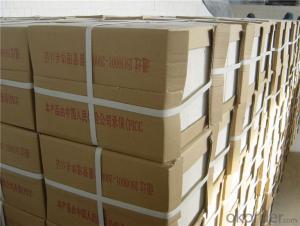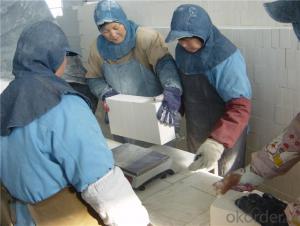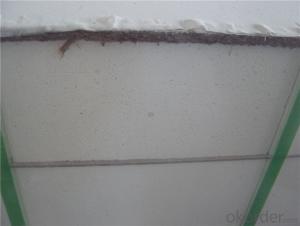Fire Clay Bricks Insulation for Glass Tanks, Shaped Fire Brick Refractory Customized
- Loading Port:
- Shanghai
- Payment Terms:
- TT OR LC
- Min Order Qty:
- 1 m.t.
- Supply Capability:
- 1000 m.t./month
OKorder Service Pledge
OKorder Financial Service
You Might Also Like
Thermal Insulation Fire Clay Brick
Refractory brick is a block of refractory ceramic material used in lining furnaces, kilns, fireboxes, and fireplaces.
We provide high quality Refractory Fire Bricks that are used on wide range in the various industries like Cement, Glass and Steel. Refractory Fire Bricks are provided as per the quantity and specifications required by the customers. We provide an extensive range of Refractory Fire Bricks at reasonable prices that depend upon the quantity ordered.
Application
Insulating Fire Brick are used for the lining of converter, alternating current arc furnace, direct Current arc furnace and the ladle slag line, etc.
Company Advantage
(1)Long Insulating Fire Brick manufacture history: 25 years manufacturer
(2)Advanced equipment
(3)Diversification of production standards: ISO ANSI FEPA JIS ASTM
(4)Flexible payment: T/T L/C D/P D/A
(5)Professional marketing team and after-sale service
Insulating Fire Brick main feature:
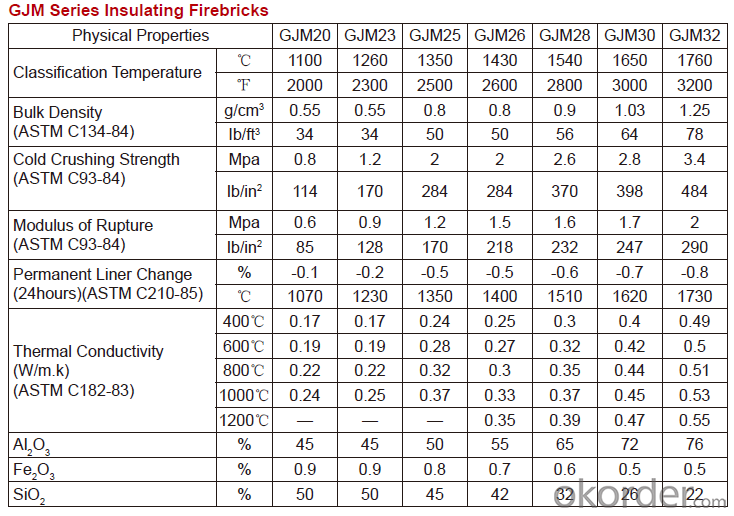
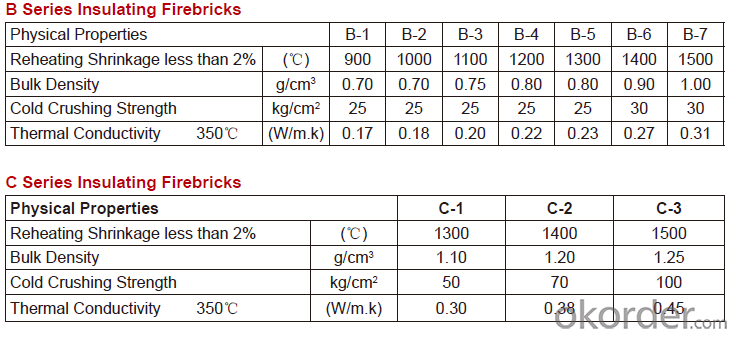
Equipment
1 unit of Ceramic Abrasive (SG Abrasive) pilot production line
2 units of Compact grain Abrasive pilot production lines
1 unit of high-end coated abrasives (abrasive cloth) production line
2 units of Boron Carbide production lines
3 large flexible crushing and sieving lines for grit production lines
6 units of 5000KVA-10000KVA dumping type electric arc furnaces for Brown Fused Alumina fusion
Q1 What’s the transport method?
A1 FCL delivery goods with wooden pallet or wooden case by sea; If LCL delivery, must with wooden case; Sometimes need open top, flat rack or bulk cargo.
Q2 What’s the required payment term?
A2 Generally 30% TT as the prepayment, 70% TT before delivery. If need, 100% Irrevocable Letter of Credit or negotiation.
Q3 Which country are our products exported to?
A3 Apart from entire Chinese market, the US, Russia, Japan, Korea, Australia and some Southeast Asian Nations.
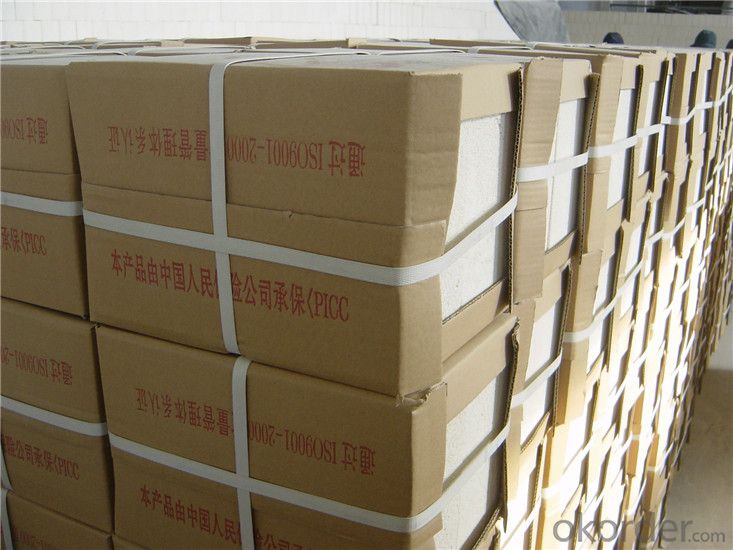

- Q:Can insulating fire bricks be used in the insulation of walls and roofs?
- Insulating fire bricks are primarily designed for use in high-temperature applications such as kilns, furnaces, and fireplaces. While they are excellent at withstanding extreme heat, they may not be the best choice for insulation in walls and roofs. Insulating fire bricks have a high thermal resistance, which means they can effectively reduce heat transfer. However, they are not as effective in preventing air infiltration or providing a high level of insulation compared to other materials specifically designed for building insulation. For insulation purposes in walls and roofs, it is more common to use materials such as fiberglass, mineral wool, foam boards, or spray foam insulation. These materials have better insulating properties and are specifically engineered to provide thermal resistance, air sealing, and moisture control. If you are considering using insulating fire bricks for wall or roof insulation, it is important to consult with a professional who can assess your specific needs and recommend the most suitable materials for your project.
- Q:Can insulating fire bricks be used in heat exchangers?
- Insulating fire bricks are indeed applicable for heat exchangers. Their design aims to provide exceptional thermal insulation, making them perfect for high-temperature scenarios like heat exchangers. These bricks are crafted from lightweight substances and possess minimal thermal conductivity, enabling them to effectively minimize heat loss or gain within the heat exchanger. Furthermore, insulating fire bricks exhibit remarkable resistance to thermal shock and can endure extreme temperatures, solidifying their reliability for heat exchanger applications. Ultimately, incorporating insulating fire bricks in heat exchangers can enhance energy efficiency and overall performance.
- Q:Can insulating fire bricks be used in ladles?
- Certainly! Ladles can indeed utilize insulating fire bricks. These bricks are specifically engineered to endure extreme temperatures while offering thermal insulation. They find frequent application in situations where the maintenance or regulation of high temperatures is necessary, like furnaces, kilns, and ladles. Ladles are employed for the purpose of pouring and transferring molten metal or other substances. By incorporating insulating fire bricks into ladles, heat loss is reduced and energy efficiency is enhanced. Moreover, these bricks serve as a safeguard against chemical reactions and erosion stemming from the molten materials, thus qualifying them as suitable for ladle usage.
- Q:Do insulating fire bricks require a specific curing or drying process before use?
- Insulating fire bricks typically necessitate a distinct curing or drying procedure prior to utilization. This action eradicates any moisture or volatile organic compounds (VOCs) that could be within the bricks and guarantees they attain their utmost insulating capabilities. The curing or drying procedure for insulating fire bricks generally entails a gradual increase in temperature, allowing the release of any moisture or VOCs without causing cracks or damage to the bricks. The rate of temperature escalation and the overall duration of the curing process may differ based on the bricks' type and thickness. Adhering to the manufacturer's instructions and recommendations for the specific type of insulating fire bricks employed is crucial. This ensures that the curing or drying process is executed accurately, preparing the bricks for use in high-temperature applications like kilns, furnaces, or fireplaces. Failing to appropriately cure or dry the bricks may lead to diminished insulating properties, as well as potential cracks or failure when subjected to elevated temperatures.
- Q:Coke burns in a closed house. Will anyone suffocate in it?
- Not suffocating in the short term, will suffocate for a long time.
- Q:What is the porosity of insulating fire bricks?
- The porosity of insulating fire bricks refers to the amount of open space or voids within the material. Insulating fire bricks are designed to have a high porosity, typically ranging from 50% to 80%. This high porosity allows for excellent thermal insulation properties by trapping air or other insulating gases within the voids. The air pockets serve as barriers for heat transfer, reducing the conduction of thermal energy through the bricks. As a result, insulating fire bricks are highly effective in maintaining high temperatures within industrial furnaces, kilns, or other high-temperature applications while minimizing heat loss. The specific porosity of insulating fire bricks can vary depending on the manufacturing process and the desired level of insulation required for a particular application.
- Q:Can insulating fire bricks be used in residential construction?
- Yes, insulating fire bricks can be used in residential construction. They are commonly used to line fireplaces, wood-burning stoves, and other heating appliances in homes. These bricks are designed to withstand high temperatures and provide excellent thermal insulation, making them suitable for residential applications where heat retention and fire protection are important factors.
- Q:Are insulating fire bricks resistant to salt attack?
- Insulating fire bricks are not typically resistant to salt attack. Salt attack refers to the corrosion and degradation of materials when exposed to salt or saltwater. While insulating fire bricks are designed to have excellent thermal insulation properties, they are not specifically formulated to withstand the corrosive effects of salt. Salt attack can lead to the breakdown of the bricks' structure, reducing their performance and durability over time. If these bricks are regularly exposed to salt or saltwater, it is likely that they will experience accelerated degradation and may not provide long-term reliability in such environments. To ensure resistance to salt attack, it is recommended to use refractory materials specifically designed for this purpose, such as salt-resistant fire bricks or refractories with higher alumina content. These materials have been developed to withstand the corrosive effects of salt and are more suitable for applications where exposure to salt or saltwater is expected.
- Q:Can insulating fire bricks be used in the construction of crucibles?
- Insulating fire bricks can indeed be utilized for constructing crucibles. These bricks are crafted from lightweight materials like clay and silica, boasting remarkable thermal insulation properties. Consequently, they are highly suitable for scenarios that require the preservation of high temperatures and minimal heat loss, such as crucible construction. Crucibles, extensively employed in industries like metallurgy and chemistry, serve the purpose of containing and melting materials at exceedingly elevated temperatures. By incorporating insulating fire bricks into crucible construction, heat loss is curtailed, energy efficiency is enhanced, and a more consistent temperature is maintained within the crucible, ultimately resulting in improved overall performance. Furthermore, the lightweight nature of these fire bricks facilitates easier handling and installation, further augmenting their appropriateness for crucible construction.
- Q:Can insulating fire bricks be used as a backup insulation material?
- Yes, insulating fire bricks can be used as a backup insulation material. Insulating fire bricks are designed to have a high thermal resistance and low thermal conductivity, making them suitable for providing insulation in high-temperature applications. They can be used as backup insulation behind other refractory materials to enhance insulation properties and improve the overall thermal efficiency of a system.
1. Manufacturer Overview |
|
|---|---|
| Location | |
| Year Established | |
| Annual Output Value | |
| Main Markets | |
| Company Certifications | |
2. Manufacturer Certificates |
|
|---|---|
| a) Certification Name | |
| Range | |
| Reference | |
| Validity Period | |
3. Manufacturer Capability |
|
|---|---|
| a)Trade Capacity | |
| Nearest Port | |
| Export Percentage | |
| No.of Employees in Trade Department | |
| Language Spoken: | |
| b)Factory Information | |
| Factory Size: | |
| No. of Production Lines | |
| Contract Manufacturing | |
| Product Price Range | |
Send your message to us
Fire Clay Bricks Insulation for Glass Tanks, Shaped Fire Brick Refractory Customized
- Loading Port:
- Shanghai
- Payment Terms:
- TT OR LC
- Min Order Qty:
- 1 m.t.
- Supply Capability:
- 1000 m.t./month
OKorder Service Pledge
OKorder Financial Service
Similar products
New products
Hot products
Related keywords

